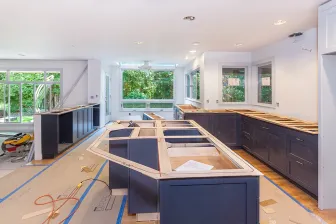Before you begin your remodel, you should have a clear picture of your goals. Whether you’re remodeling a single room or making small changes throughout your home, setting clear goals early on can help you stay on track and avoid unnecessary expenses. This means taking the time to look at your home and determine which areas really need improvement and which can wait. Knowing what changes you want and how important they are will help you make choices that are more suited to you and your budget. If you decide to hire a professional, having a clear plan from the start will also help you better understand your ideas.
Set a Realistic Budget and Stick to It
Creating a budget plan that you can stick to is the first step to a successful remodel on a budget. Please compile a list of all anticipated costs, including supplies, labor, permits, and any small fees to cover additional expenses. This will show you what you can afford and where you may need to compromise. Be honest about how much you can afford, and don’t spend more than you can. If you have limited funds, it might be a good idea to renovate in phases rather than doing it all at once. Prioritizing the most important changes guarantees the optimal use of your resources. Adhering to your budget also enables you to control your emotions when you encounter visually appealing changes that ultimately exceed your initial budget.
Focus on High-Impact, Low-Cost Improvements
If you have a limited budget, it’s best to focus on changes that make a big difference in appearance or functionality but don’t cost a lot. Painting the walls, replacing light fixtures, replacing cabinet hardware, or installing new window treatments can all give a room a fresh look. Often, these minor adjustments can significantly impact the overall renovation. Search for small changes that can make a space more beautiful and functional without making major architectural or structural changes. These small, practical changes can make your home look and feel better while keeping costs down.
Choose Things you can do Yourself
Hiring someone to do these jobs is often the most expensive part of a renovation. You can save a lot of money by doing many things yourself. Many people can do simple jobs like painting, sanding, assembling furniture, or installing shelves. With a little time to learn, you can even do small jobs like laying tiles or installing laminate flooring yourself. There are many step-by-step guides available online. But be honest with yourself. If you need help with plumbing or a remodel, you need to know when to call in a professional. You can do what you can and only ask for help when you need it, which can make your renovation efficient and cost-effective.
Plan Carefully and Plan Each Step
By planning everything in advance, you can avoid delays and mistakes that can cause giant losses. Organize your tasks and deadlines, considering the arrival of supplies and the availability of assistance. A thorough plan can help you stay on track and calm during the renovation process. You can also coordinate tasks better with a thorough plan. For example, painting the walls before installing the new flooring can prevent damage from mistakes. Mistakes and extra work can be costly on a tight budget. A successful plan can help you get the job done faster and more efficiently.
Repurpose Existing Materials
Using existing materials is one of the best ways to save money on home renovations. Before you throw out cabinets, doors, and chairs, think about how you can reuse them or give them a new look. Painting or refurbishing old items is an affordable way to give them a new look. You can make shelves or decorations out of old wood, or you can move furniture and give it a new purpose. Using existing items creatively and practically not only saves money but also gives your home a unique and personal touch. This approach is in line with sustainable living, saving money, and protecting the environment.
Avoid Structural Changes if Possible
Changing the structure of your home, such as removing walls or moving plumbing and electrical lines, can significantly increase the cost of a renovation. If you want to stay within your budget, try to stick to your original plan and avoid major structural changes. Instead, use design and decor to enhance the existing space. You can solve many problems without making major changes to the space. For example, mirrors can make a room appear larger, moving furniture around can make moving easier, and adding smart storage can save money. Keeping your home as it is can reduce costs and construction time, allowing you to focus on the exterior.
Conclusion
With the right mindset and planning, you can successfully complete a home renovation even on a tight budget. Setting clear goals, creating a budget you can stick to, and making smart, informed decisions can help you transform the look of your space without going over budget. By concentrating on major renovations, reusing materials, and engaging in DIY projects, you can achieve more value for your money than you may anticipate. The process will be smoother and the rewards greater if you plan carefully, research thoroughly, and are willing to be flexible. With patience and imagination, your home can become more beautiful, functional, and enjoyable. This exercise proves that a limited budget doesn’t have to stop you from achieving your goals.
FAQs
1. What should you do first to plan an affordable home improvement project?
First, you need to figure out your goals for your renovation and create a budget that fits them.
2. How do you get the best deal on your renovation?
Doing some of the work yourself, reusing existing materials, not changing the structure of your home, and comparing material and labor prices are the best ways to save money.
3. Is it cheaper to renovate your entire home at once or one room at a time?
If you have a limited budget and limited resources, it is easier and cheaper to renovate one room at a time.
4. What should you avoid when renovating on a budget?
Don’t make hasty decisions, skip the planning phase, or spend money on unnecessary luxuries that won’t help you achieve your goals.
5. Can I renovate my home without taking out a loan?
Yes, you can renovate your home without going into debt if you plan ahead, control your expenses, and make smart choices.




